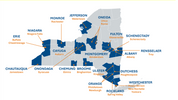Throughout Western New York and all across the United States, the number of murals gracing streetscapes has grown exponentially. Murals are increasingly popular destinations for tourists and act as backdrops to many personal photographs. However, there have been instances where murals were incorporated into commercial advertising by companies without seeking permission or providing compensation to the creator. This article discusses the evolving case law and how courts have interpreted the copyright issues associated with using murals in commercial advertising. Ultimately, many of these cases settle prior to courts making a complete and final determination on the merits.
Congress passed the Architectural Works Copyright Protection Act (“AWCPA”) in 1990, which amended the current United States Copyright Act. The Copyright Act includes eight categories of original work of authorship given copyright protection. These include pictorial, graphic, and sculptural works under 17 U.S.C. § 102(a)(5) and architectural works under § 102(a)(8). However, the general protection afforded to architectural works is limited by § 120(a), stating “[t]he copyright in an architectural work that has been constructed does not include the right to prevent the making, distributing, or public display of pictures, paintings, photographs, or other pictorial representations of the work, if the building in which the work is embodied is located in or ordinarily visible from a public place.” Several cases, discussed later in this article, have examined this provision of the copyright act and its application to murals located on the architectural work.
Another consideration is the Visual Artists Rights Act of 1990 (“VARA”), which states “the author of a work of visual art . . . shall have the right to prevent any intentional distortion, mutilation, or modification of that work which would be prejudicial to his or her honor or reputation, and any intentional distortion, mutilation or modification of that work is a violation of that right.” See 17 U.S.C. § 106A(a)(3)(A).
One of the first cases to examine the § 120(a) exemption noted above was Leicester v. Warner Brothers.[1] In this case, the court considered whether a sculptural work commissioned as part of an architectural project should be afforded copyright protection after it was used by Warner Brothers in its film, Batman Forever. The work was used without the artist’s permission in conjunction with the construction of the 801 Towers in Los Angeles. The district court determined that the four tower sculpture at issue had “functional aspects designed to be part of the building plan and from their appearance are designed to match up with the architecture of the building.” The district court used a fact-specific analysis to come to this determination, which the Ninth Circuit affirmed.
The district court also discussed whether the concept of “conceptual separability” survived the 1990 amendments to the United States Copyright Act. As noted by the court in Falkner v. General Motors LLC, when discussing Leicester, “[p]rior to the inclusion in 1990 of ‘architectural works’ as a category of protected works under amendments to the Copyright Act, buildings had no copyright protection. However, portions of buildings that consisted of original artistic work and were ‘not a part of a functional, utilitarian, or useful role in the architecture’ were considered ‘conceptually separate’ from the building and were independently and fully protected under Section 102(a)(5).” The court in Leicester looked at relevant legislative history and concluded that “the intent of Congress was to substitute the new protection afforded architectural works for the previous protection sometimes provided under the conceptual separability test for non-utilitarian sculptures.” Thus, the result of this interpretation was that “the former doctrine of conceptual separability as it applied to a pictorial, graphic, or sculptural (“PGS”) work embedded as part of a building, was modified by the 1990 amendments and does not provide independent protection for embedded PGS works.” See Falkner v. General Motors at 932. The Ninth Circuit in Leicester affirmed the judgment and mainly deferred to the findings of the district court. As interpreted by the court in Falkner v. General Motors, “all three judges on the Ninth Circuit panel unambiguously agreed that, for Section 120(a) to apply to a PGS work that is not itself an architectural work, the PGS must be ‘part of’ an architectural work.” Falkner at 934.
Mural Cases
Two more recent decisions out of California and Michigan examine § 120(a) as it relates to the commercial use of murals and whether murals painted on buildings and subsequently used in advertising campaigns are afforded protection under the United State Copyright Act or whether the § 120(a) exemption applies. Both cases ultimately settled without rendering a final decision on the issue, but the facts and development in each case continue to be relevant today and many cities become a walking art gallery, with their architectural buildings serving as the canvas.
Falkner v. General Motors LLC
In Falkner v. General Motors LLC, the court denied the defendant’s partial motion for summary judgment on the issue of whether § 120(a) applies to a mural painted on a parking garage. In this case, General Motors’ advertising agency posted a photograph of a Cadillac, which included a portion of a mural painted by Falkner on a parking garage in Detroit. The issue in this case is whether § 120(a) applies to a PGS work that is physically connected to an architectural work. As briefly highlighted previously, the court in Falkner goes through an extensive analysis of the Leicester decision. The court determined that a parking garage falls within the definition of a building and that buildings are architectural works. The next issue to court looked to was determining whether the mural was “part of” the parking garage for the purposes of § 120(a) using the factors established in Leicester. For General Motors to prevail, the court must determine that the mural is part of the parking garage and therefore exempt under § 120(a).
Ultimately, the court could not say as a matter of law that the mural was part of the parking garage. The court highlighted several of the Leicester factors that go into making this determination. These include: (1) whether the PGS work had a concept that integrated it into the underlying architectural work; (2) whether the PGS work could itself be considered an architectural feature; and (3) PGS may be part of an architectural work when they are designed to appear as part of the building or when they serve a functional purpose that is related to the building. The court went on to state that very few of these factors seem to be present in the case of the mural on the parking garage, and “because the facts in the record tend to establish . . . the lack of a relevant connection between the mural and the parking garage, the Court cannot hold as a matter of law that the mural is part of an architectural work under § 102(a)(8).”[2] The court, therefore, could not reach the issue of whether the § 120(a) exemption would apply. The court did determine that the artist was not entitled to punitive damages and granted General Motors’ motion for partial summary judgment after the defendants argued as a matter of law “punitive damages are not available in statutory copyright infringement actions.”[3]
An additional argument made in this case related to the Digital Millennium Copyright Act (“DMCA”). 17 U.S.C. § 1202(b) states: [no] person shall, without the authority of the copyright owner of the law (1) intentionally remove or alter any copyright management information; (2) distribute or import for distribution copyright management information knowing that the copyright information has been removed or altered without authority of the copyright owner or the law.; or (3) distribute, import for distribution, or publicly perform works, or phonorecords, knowing that copyright management information has been removed or altered without authority of the copyright owner or law.
The court in Falkner ultimately determined that no reasonable jury could find that the copyright management information had been removed or altered. In this case, the photograph showed only one of two walls that included the mural.
Mercedes Benz USA LLC v. Lewis
In Mercedes Benz USA LLC v. Lewis, Mercedes Benz commenced a declaratory judgment action arising out of alleged copyright infringement violations asserted by three artists concerning each of their respective murals.[4] Mercedes Benz photographed several locations in Detroit in connection with an advertising campaign. Included in the photographs were all or parts of the defendant artists’ murals. The defendants filed motions to dismiss, however, the court determined that Mercedes Benz had alleged a plausible claim that § 120(a) of the AWCPA protects its right to photograph publicly visible buildings which contained the defendants’ murals. At the motion to dismiss phase, the court did not address whether the AWCPA argument would prevail. Ultimately, this case settled as well.
The law on this issue remains unsettled given the differing outcomes of both cases discussed above and the fact that most of these cases settle prior to the rendering of a final decision on the issue. Artists and companies should be aware of the potential legal implications stemming from the use of murals in commercial advertising.
Fair Use Defense
Fair use remains a viable defense to copyright infringement claims. However, commercial use typically does not fall within a fair use defense. This defense is available when the copyrighted material has been used “for purposes such as criticism, comment, news reporting, teaching (including multiple copies for classroom use), scholarship, or research.[5] There are several factors to analyze when determining if the fair use defense applies. These include (1) purpose and character of the use, including whether such use is of a commercial nature or is for nonprofit education purposes; (2) nature of the copyrighted work; (3) amount and substantiality of the portion used in relation to the copyrighted work as a whole; (4) effect of the use on the potential market for or value of the copyrighted work.[6]
[1] Leicester v. Warner Bros., No. CV-95-4058-HLH (CTX), 1998 WL 34016724 (C.D. Cal. May 29, 1998).
[2] Falkner v. General Motors LLC, 393 F. Supp. 3d 927, 937 (C.D. Cal., 2018).
[4] Mercedes Benz, USA, LLC v. James Lewis, Jeff Soto and Maxx Gramjo, Daniel Bombardier, No. 19-10948, 2019 WL 4302769 (E.D. Mich. September 11, 2019).
[5] 17 U.S.C. § 107; see also “Fair Use: An Exception to Copyright” Case Western Reserve University, https://case.edu/library/services/copyright/fair-use-exception-copyright.
[6] “Fair Use: An Exception to Copyright” Case Western Reserve University, https://case.edu/library/services/copyright/fair-use-exception-copyright.
 unknownx500
unknownx500










